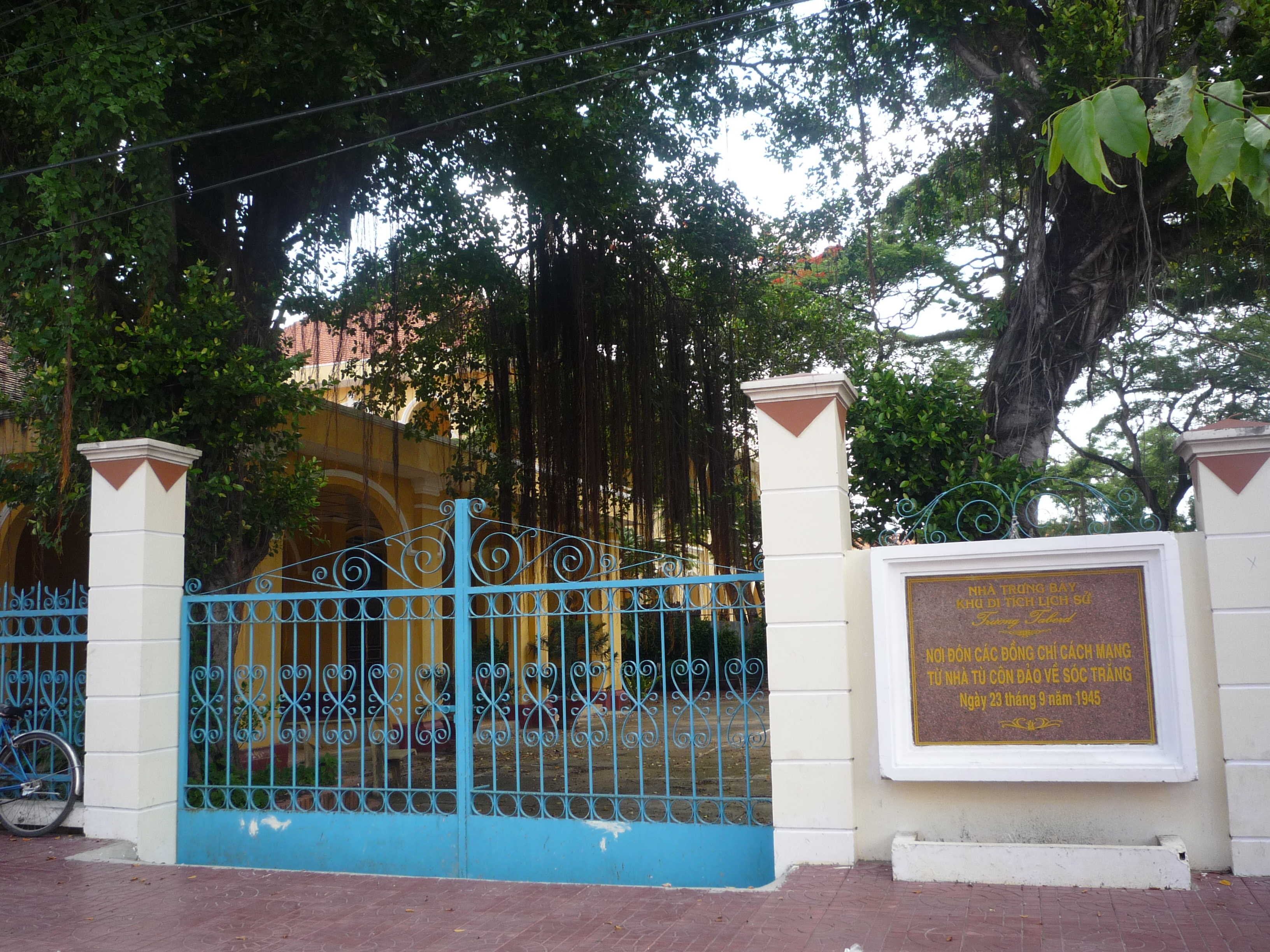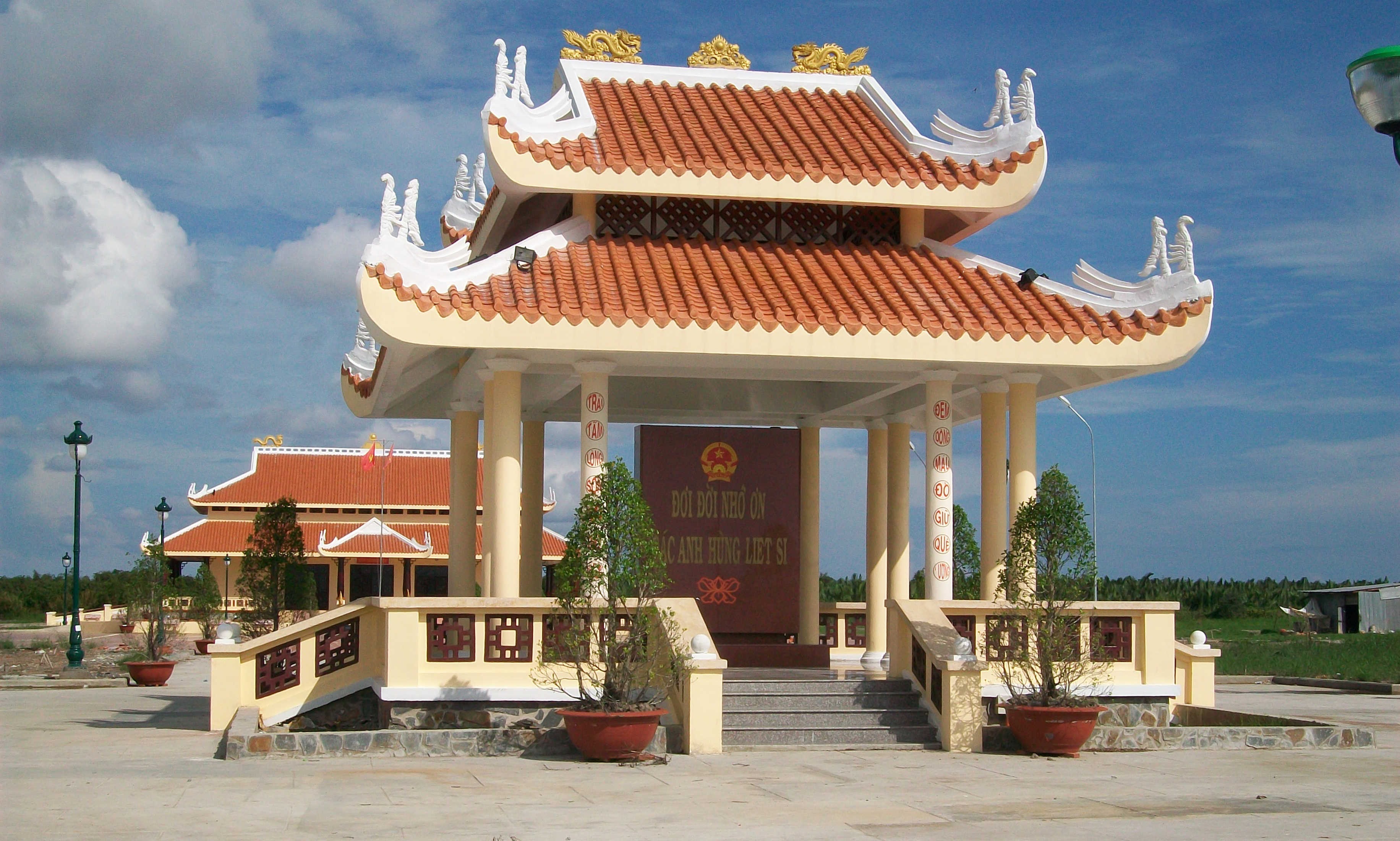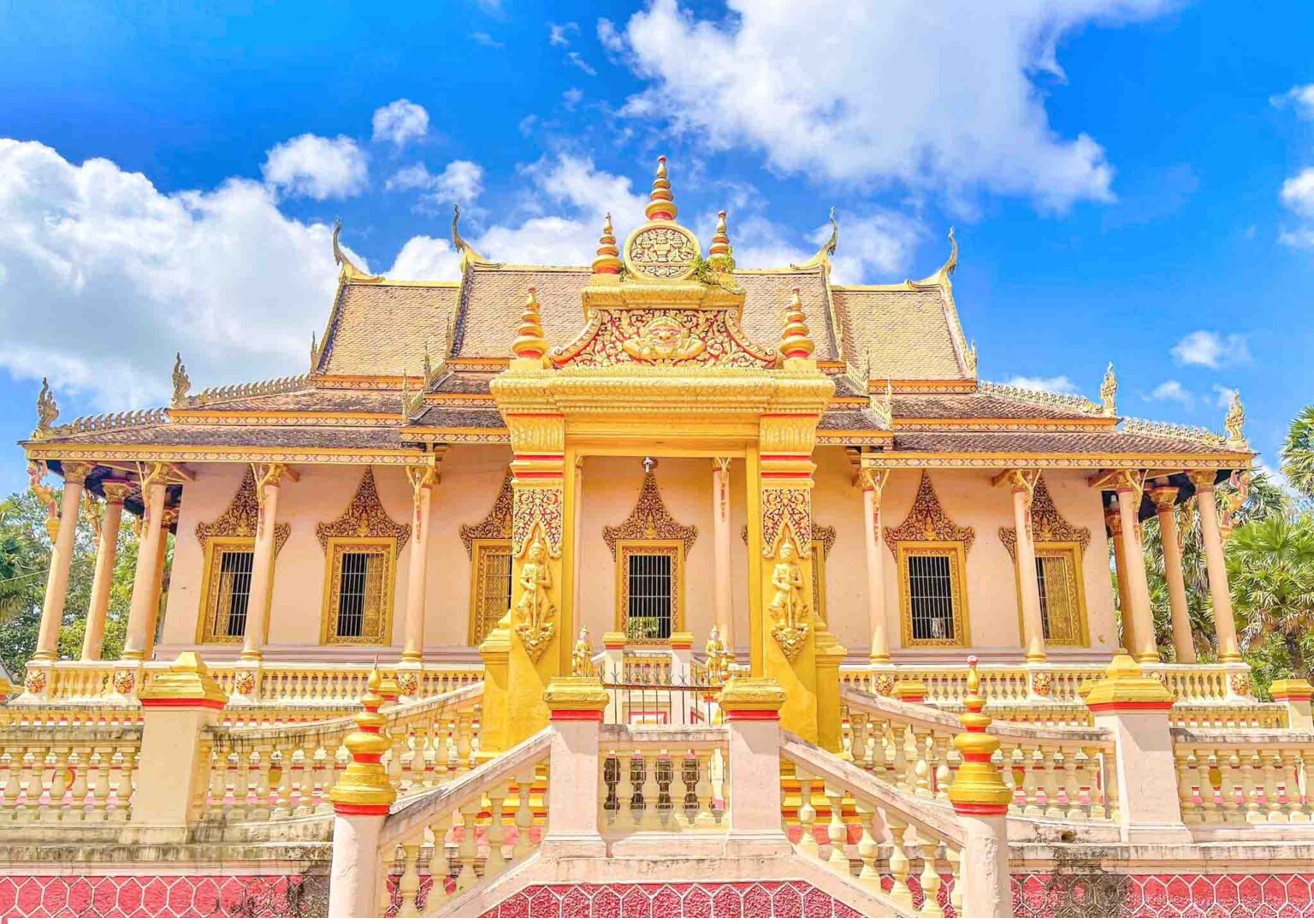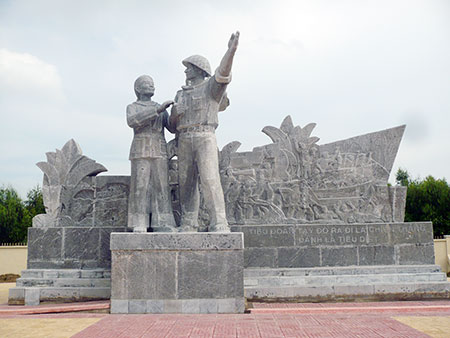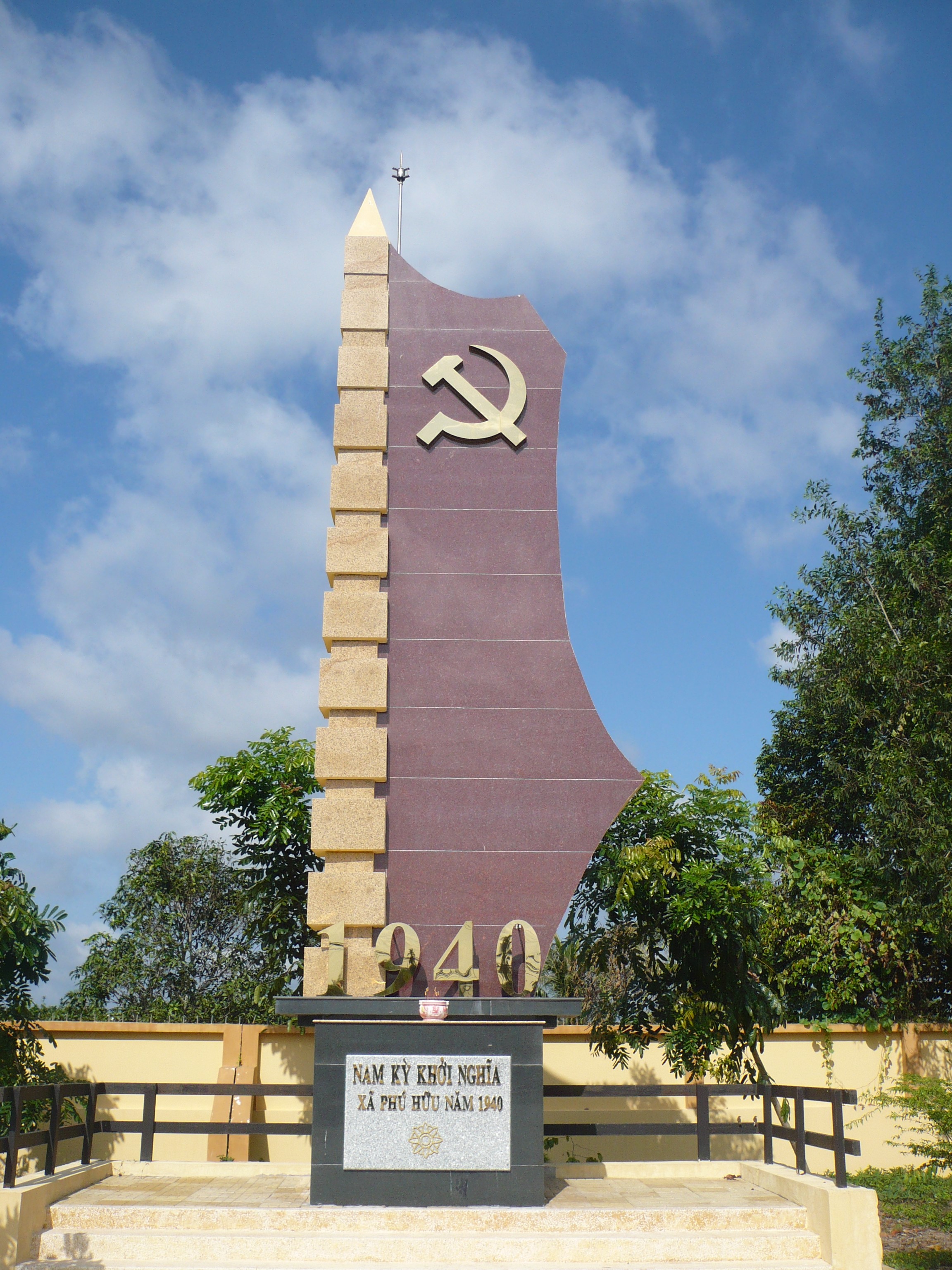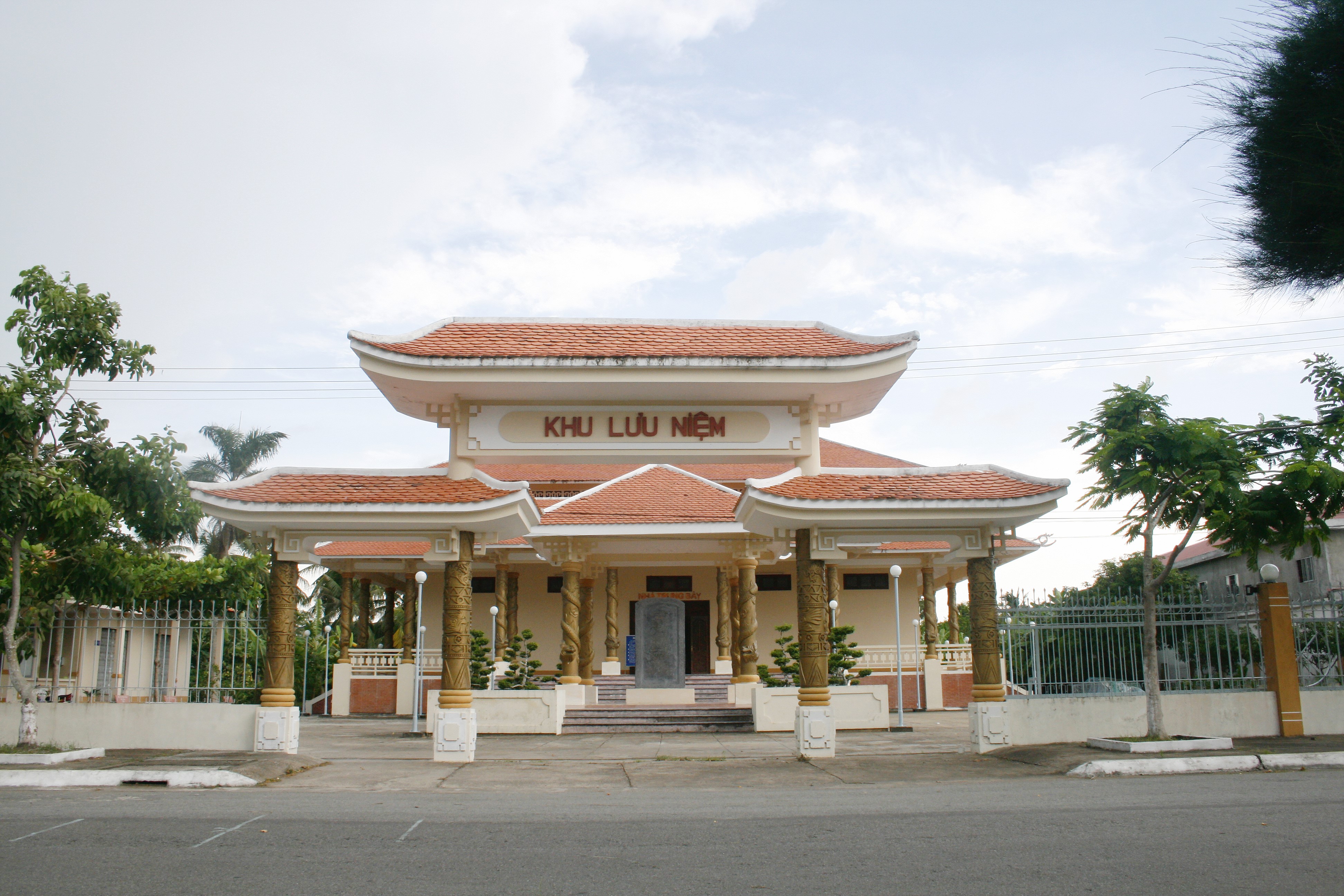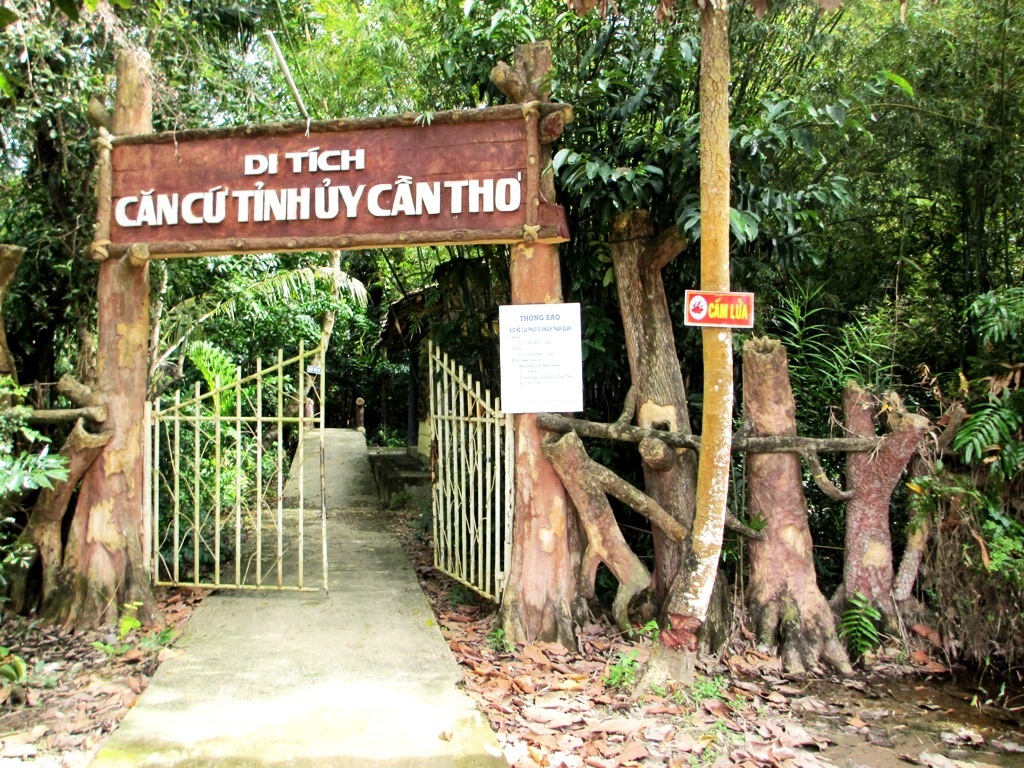Relic point Vietnam
Việt NamTaBerd School historical site
Taberd Soc Trang School's historical and cultural relic site is today located on the campus of Ischool High School located at 19, Ton Duc Thang, Ward 6, Soc Trang city, Soc Trang province. The reason the relic is called Taberd School is because in the past this was a boarding elementary school of a French Catholic organization, built in 1912. The school has a campus of 11,128 square meters, accommodating several thousand people. . This place marked an important revolutionary event, recognizing the great contributions of the Party Committee, army and people of Soc Trang in the resistance war against the French. After the victory of the August Revolution in 1945, our Party quickly consolidated and built the revolutionary government, stabilized society, and took care of the people's lives. At the same time, deal with the French colonialists' plot to return to invasion. In the South, the Nam Ky Provincial Party Committee assigned the Soc Trang Provincial Party Committee an important and urgent task, which is to organize the reception of officers and soldiers returning from Con Dao. At 7:00 pm on September 23, 1945, a boat carrying about 2,300 people, including more than 1,800 political prisoners from Con Dao, arrived in Soc Trang and arrived at Cau Noi wharf, also Cau Tau port in six provinces. And Taberd School with its spacious campus and next to Noi Bridge was chosen as a place to stop and rest for Con Dao political prisoners from September 23 to September 30, 1945. Here, Con Dao political prisoners were enthusiastically welcomed by thousands of Soc Trang compatriots amid a forest of torches, flags and banners. Tens of tons of rice, salt sugar, hundreds of pigs, chickens, ducks and thousands of clothes, blankets, mats, mosquito nets, boards... were donated by the people to prepare to welcome the group, a service team consisting of hundreds of men. The young woman was in a ready position to serve. After September 30, 1945, the group of Con Dao political prisoners departed for Can Tho to receive new tasks. By welcoming and taking care of Con Dao political prisoners, the Party Committee and people of Soc Trang have successfully completed an important and meaningful task, contributing to building and firmly protecting the achievements of the revolution, bringing The Vietnamese revolution went from victory to victory. With the meaning and importance of the event, on June 11, 1992, the Ministry of Culture and Information decided to recognize Taberd School in Soc Trang as a national historical relic, a type of revolutionary historical relic. . The showroom is arranged with 6 major contents: The first content is "Con Dao Prison - Hell on Earth": includes a number of images of Con Dao prison and prisoners taken, showing a part of the torture and brutal torture of political prisoners. treatment in colonial prisons. The second content is the successful August Revolution of 1945: The third content is: The event of welcoming a group of Political prisoners from Con Dao to the mainland. The fourth content is: The 7-day process of taking care of officers and soldiers at Taberd School. The fifth content is: Typical characters. Source: Electronic information portal of Soc Trang City People's Committee
Can Tho 4691 view
Historical relic of Soc Trang Provincial Party Committee Base
Soc Trang Provincial Party Committee Base Relic has an area of 281 hectares, located in My Phuoc Melaleuca forest, in My Phuoc commune, My Tu District, Soc Trang province. The center of the relic site is the Hall, where thousands of meetings of the Party Committee and the Executive Committee of the Soc Trang Provincial Party Committee took place during the resistance war. Previously, the Hall was temporarily built with materials available in the forest such as: Melaleuca, nipa palm leaves, etc. After the year Mau Than 1968, to adapt to the new situation, and at the same time build a solid base to hold on. Long-term resistance pillar, the Hall was rebuilt with square oilwood, split-leaf roof, 4.7m high, 20m long, 4m wide and divided into 5 equal compartments. On both sides of the Hall, there are 4 concrete bunkers, used to hide when enemy aircraft or artillery bombard them. There are 2 floating bunkers, 1 can hold 10 to 15 people and 2 submerged bunkers, 1 can hold 20 to 25 people. In particular, to ensure the safety of the core leadership force, the Base is also equipped with 2 additional secret bunkers about 300m away from the Conference Hall, in which reserve food and necessary items are prepared, each day. The bunker holds about 10 to 13 people. In addition, the Base Area also has the Secretary's office and many camps of affiliated agencies built in field form. The Soc Trang Provincial Party Committee base area was also called My Phuoc Base by the people during the war because this base was formed and built in the cajuput forest in My Phuoc commune. Previously, this area was just a desolate field full of weeds, tens of thousands of acres wide, then people came here to explore, settle and establish hamlets. In the early 20th century, after occupying 6 Southern provinces including Bien Hoa, Gia Dinh, Dinh Tuong, Vinh Long, An Giang, Ha Tien - Soc Trang area in An Giang province, France promoted resource exploitation and land occupation. agricultural products, forcing people to dig canals and grow melaleuca. At that time (1926), Soc Trang province had 4 districts: Chau Thanh, Ke Sach, Long Phu and Phu Loc. At that time, My Phuoc belonged to Chau Thanh district. By August 25, 1945, after the people of Soc Trang successfully seized power, this Melaleuca forest was the property of the people. After the success of the August Revolution, the whole country urgently built and strengthened its forces to prepare resistance plans to continue fighting against the French colonialists. The Soc Trang Provincial Party Committee advocated expanding the workshop to manufacturing weapons to equip the armed forces and serve the resistance war, so in April 1946 the Soc Trang engineering factory was born in the Melaleuca forest. To contribute to the failure of the French strategy of "fighting quickly, winning quickly" and preserving long-term resistance forces, in September 1947 the Soc Trang Provincial Party Committee decided to move the Base from Cu Lao Dung (at that time in Long district). Phu) to My Phuoc cajuput forest. Here, the Provincial Party Executive Committee implemented the Resolution of the Party Central Committee, directly directing combat strategies for the army and people of Soc Trang on all fronts from armed to political. It can be said that My Phuoc Base at that time was the guiding headquarters of the Soc Trang Provincial Party Committee, making an important contribution to the country's common resistance war to defeat French colonialism. After 1954, when the US pushed France to occupy Indochina, under the puppet government of Ngo Dinh Diem, on October 20, 1956, Soc Trang province was renamed Ba Xuyen province. With the policy of "denounce the public, destroy the communists", the puppet government brutally murdered communists. Faced with that situation, thoroughly grasping the ideology in Resolution 15 of the Party Central Committee (1959), from the My Phuoc Melaleuca Forest Base, the Soc Trang Provincial Party Committee launched a co-insurgency movement throughout the province, starting the revolutionary path. violence against US imperialism and its henchmen. From here, the Soc Trang Provincial Party Committee continued to bring the struggle movement of the army and people from victory to victory until the day Soc Trang province was completely liberated (May 1, 1975). With those values and meanings, on June 16, 1992, the Ministry of Culture and Information recognized the Provincial Party Committee Base as a national-level Revolutionary Historical Relic. Source: Soc Trang Tourism Promotion Center
Can Tho 4218 view
Khleang Pagoda
Khleang Pagoda is located right in the city center, located on Ton Duc Thang Street, Group 5, Ward 6, Soc Trang City. The pagoda was built nearly 500 years ago, associated with the legends of Soc Trang. The main hall of the pagoda is built on high and wide ground, the space is clear and green, especially there are many palm trees, a typical tree of the Khmer people. The pagoda has been restored many times, but it was not until 1918 that the Main Hall and Sala were rebuilt and all materials were replaced. Still an architectural characteristic of the Southern Khmer people with the dragon image on the roof. In Buddhist stories, Khmer people often say that: Dragon is a sacred animal, it turns itself into a boat to take Buddha across the sea to places to preach sutras and save sentient beings. Therefore, the Dragon was brought to the roof of the temple with the intention of hoping that Buddha would stop and save them from their damnation. Adjacent to the roof of the main hall is the image of the god bird Krud strongly supporting the roof. According to Khmer folk legend, the god bird Krud is the king of birds. In front and behind the main hall of the pagoda, there is the image of Chan standing to protect the pagoda. In Khmer fairy tales or in Du-Ke, the character Chan is a symbol of evil and ugliness, causing suffering for people. everybody. However, in Khmer visual art, Chan was conquered by Buddha. Placing the Chan statue outside the main hall implies that evil and ugliness have been transformed to serve and protect beauty and goodness. Inside the main hall is a large room reserved for ceremonies. In addition to the 12 round columns, the most important part inside the main hall is the altar of Shakyamuni Buddha statue, a 2.5m high statue placed in the middle of the two innermost rooms, not only precious in terms of materials but also in terms of sculptural art. On the altar, there are dense patterns with delicate sculptures and flame-shaped patterns that are very typical of Khmer culture. A refined aesthetic sense emerges into inspiration. Because they follow the Theravada Buddhist system, the pagodas of the Southern Khmer people only worship Shakyamuni Buddha in many different positions: meditating, newly born, begging for alms, at nirvana, etc. The interior of the main hall of the pagoda is the intersection of three cultures: Kinh, Khmer, Chinese in an architectural space, clearly shown on wooden pillars: Vietnamese lacquer art, traditional color coordination. Khmer traditions and typical Chinese drawings, creating a masterpiece that perhaps only exists at Khleang Pagoda. In addition to its role as a religious base, the main hall of the pagoda also stores and preserves a collection of Buddha statues with many different postures, sizes, and materials, likened to an ancient art museum of artifacts. These artifacts have been preserved by many generations of monks for hundreds of years, with contributions from many Buddhists. Since the beginning of the temple's construction until now, Khleang Pagoda has had 21 abbots and the current abbot is Venerable Tang No (1943). Some not only took care of building pagodas but also actively participated in revolutionary activities such as preventing conscription, nurturing famous revolutionary cadres... some had to sacrifice themselves before the enemy's guns like Dai Duc. Tran Ke An, the head monk, was murdered by enemies right in the back of the temple. Therefore, during the years of the resistance war against America to save the country, the pagoda was both a place for organizing religious activities and the most effective place for revolutionary activities of the Party. Over the years, with its important historical significance and preserved architectural value, Khleang Pagoda was recognized by the Ministry of Culture as a national historical and cultural relic on April 27, 2019. 1990. Source: Electronic information portal of Soc Trang City People's Committee
Can Tho 3708 view
Historical relic site - Location of the establishment of Tay Do Battalion
Relic Location of the establishment of Tay Do Battalion, located on the bank of Lai Hieu canal in Phuong An hamlet, Phuong Binh commune, Phung Hiep district, Hau Giang province, 25 km from Vi Thanh city, the center of the province, 25 km from the town. Nga Bay is 16 km away, convenient to travel by road and waterway to the monument. At the end of 1959, Resolution 15 of the Central Committee and Resolution of the Western Interprovincial Party Committee were implemented, and the armed forces of the entire Region were born one after another, including the Tay Do Battalion. Established on June 24, 1964 in Phuong Binh commune, Phung Hiep district, Can Tho province (now Hau Giang province). Because the Provincial Military Committee held a very solemn launching ceremony for the Battalion, with 1,000 people, officers and soldiers attending, the Provincial Military Committee had comrade Le Hoang Lau, Provincial Captain, who attended and announced the Decision to establish the Battalion. established the Tay Do Battalion, and at the same time assigned tasks to the Party Committee and the Battalion Command Committee. Comrade Bui Quang Do, on behalf of the Battalion Party Executive Committee, read the response and promised and vowed to be loyal to the Party and the people. people. Comrades shouted the slogan "Tay Do Battalion leaves and wins, fights and destroys". All officers and soldiers of the Battalion unanimously shouted "Determined victory". Born in the midst of the fierce resistance war against America to save the country, the Tay Do Battalion quickly grew up, fought heroically, achieved many resounding victories, and contributed to the liberation of the country's army and people. completely South, unified the country, fulfilled international obligations in Cambodia... was twice honored by the Party and State with the title "Hero of the People's Armed Forces". With the achievements of the Tay Do Battalion, on July 26, 2006, the People's Committee of Hau Giang province issued a decision to classify the historical and cultural relic "Place of the founding of the Tay Do Battalion" as a level relic. conscious. The relic is planned and invested in the construction of construction items such as: monumental monument, house displaying images of artifacts of the Tay Do Battalion, yard, internal roads, trees,... on an area of 01 ha The land is also in Phuong An hamlet, Phuong Binh commune, Phung Hiep district, Hau Giang province. The project was completed and put into use in 2012. It has great significance in educating the young generation about revolutionary traditions. This place has become one of the important relics of the province that is regularly opened. Serving visitors, studying, meetings, cultural activities, and entertainment of people inside and outside the province. Source: Department of Cultural Heritage Management
Can Tho 3904 view
Pho Minh Pagoda
On October 5, 2021, the People's Committee of Hau Giang province issued a decision to classify Pho Minh Pagoda (located at 135/2 Nguyen Thi Minh Khai street, area Area 1, Ward 4, Vi Thanh city, Hau Giang province). Pho Minh Pagoda was built before 1908 (before the 20th century) and is one of the oldest pagodas in Vi Thanh city. The pagoda is both a mark of religious history and a red address in two wars. resistance war against France and America, used to be a place for revolutionary cadres during the war against France and America to reside. Initially, the pagoda was only built with leaves on stilts, because at that time there were countless snakes, centipedes, tigers and leopards here. After many generations of abbots, in 1967 the pagoda was rebuilt but also made of leaves. At this time, the resistance war against America and its henchmen was extremely fierce. Meanwhile, the enemy increased military service, so many local young people voluntarily "bared their hair" to enter the temple to avoid their coercion. Since 1908, the pagoda regularly contributed rice and money to support the revolution, built secret bunkers to hide officials, and protected hundreds of local young people who escaped the military draft. The pagoda's campus is spaciously built with many beautiful and majestic statues. The campus of more than 1 hectare has a green garden, a solemn and quiet landscape, especially a quite large and beautiful lotus pond. The main hall is very spacious and spacious with many institutions such as altars for Buddha and saints; Rare drums, bells, gongs and many very ancient and culturally valuable artifacts. From 1968 to 1975, the pagoda sheltered and supported nearly 130 people. “Among these are many cases of secret revolutionary activities. Every day, they stay in the temple, but during the harvest season, they return to visit their families during the day and return to the temple at night. To protect and protect the higher-ranking officials who came to grasp the enemy situation and discuss battles, the late monk Thich Hue Giac secretly dug a shelter behind the pagoda. Not to mention, in order to deceive the American puppet, the late monk Thich Hue Giac also used bamboo bedding to surround the mouth of the tunnel, then filled it with coconut shells. Thanks to that, many times revolutionary activists took refuge here when being raided by the American puppet regime and were safely protected. On April 30, 1975, President Duong Van Minh announced his surrender, Ho Ngoc Can declared his death, and many "monks" stripped off their monks' robes to grasp the enemy's situation and continue digging fortifications to prevent a counterattack. of them. At this time, many puppet soldiers' wives and children ran to the stations to find their husbands and fathers. Seeing this, the late monk Thich Hue Giac campaigned and propagated them to advise their relatives to put down their guns and surrender. Thanks to that, about more than an hour later, the governor's palace pulled down the 3-striped flag to hang the white flag at the head of the line. After the liberation and unification of the country, the monks and nuns of Pho Minh Pagoda continued their mission of building and protecting the Dharma and the nation. During the resistance war against the US, Pho Minh Pagoda was a secret operation base, often donating rice and money to support the revolution. In particular, the pagoda is the location of secret activities of the family of former Prime Minister Nguyen Tan Dung's wife; Major General Tran Quoc Liem, Deputy Director of the General Department of Security (Ministry of Public Security); Mr. Le Viet Hung, former Deputy Director of Can Tho City Police; Security team, Vi Thanh town special forces team... Source: Vietnam Buddhist Church
Can Tho 3875 view
Historical relic site of the 1940 southern uprising, in Phu Huu
The 1940 Southern Uprising relic was previously located in Phu Huu village, Dinh An district, Phung Hiep district, now in Phu Thanh hamlet, Phu Hoa commune, Chau Thanh district, Hau Giang province. In the years 1930 - 1935, farmers in Phu Huu village lived in a situation of heavy oppression and exploitation by the French colonialists and feudal landlords. During this time, on the other side of the left bank of the Hau River, Tra On and Vinh Xuan Party cells were born and led the people to fight against rentier landlords, feudalists, and colonialists. The Party cell in Phu Huu was born and led a very vibrant peasant struggle movement and built a very good revolutionary base. From the base with the cell and the house of Mrs. Ngo Thi Lua (mother of comrades Nguyen Phuoc Ngoan and Nguyen Van Phuc) in Nga La canal, Phu Le hamlet, Phu Huu village, the Can Tho Inter-Provincial Party Committee chose as the place to locate the agency. Here, the Can Tho Inter-Provincial Party Committee has opened many training classes, many conferences of the Inter-Provincial Party Committee and printed many documents to provide for Hau Giang provinces. Under the leadership of the Party cell, the movement to fight for rent reduction, income reduction, people's livelihood, and democracy took place strongly and enthusiastically; Grassroots organizations of the Party and the masses: Youth and women opposed the empire, the Red Farmers' Association developed strongly, especially since receiving the "Uprising Outline" of the Cochinchina Regional Party Committee deployed by the Can Tho Provincial Party Committee in September. April 1940. The Party cell diligently prepared for the uprising, organized many good mass meetings to launch the movement and chose a place in the deep forest to build a hut under the shade of palm trees (hence the name "Cay Ke" hut). ) to serve as a learning and training place for young people and farmers with revolutionary enthusiasm in the village. These meetings often had senior officials such as comrades Luu Nhan Sam and Ngo Huu Hanh (in the Can Tho Provincial Party Committee) often come to talk about the situation, practice revolutionary songs and teach martial arts. The activities of the masses under the leadership of the cell, preparing for the uprising were secret but very exciting, everyone looked forward to the day the uprising would seize power. The uprising order from the Southern Party Committee arrived in Can Tho at 12 noon on November 22, 1940, but it was not until late at night on November 23, 1940 that the Phung Hiep District Party Committee received the uprising order. Although it was late, the District Party Committee still carried out the uprising. The task of the Phung Hiep District Party Committee was to organize an insurrection force to attack the district capital, attack the Phung Hiep bridge and surround and hold back the enemy from going to reinforce elsewhere. The enemies in Tra On were informed that district chief Chi sent troops to suppress the uprising. The core leaders of the uprising and the patriotic masses were arrested and sentenced to life imprisonment to five years in prison and exiled to Con Dao. Because he could not bear the imprisonment in the natural forest and toxic water, he sacrificed himself here. Although the Cochinchina uprising in Phu Huu and some places in the province did not win, because the revolutionary situation was not yet ripe, the uprising plan was revealed, so it was brutally suppressed by the enemy, many cadres, party members and The Party's loyal masses were massacred by the enemy, arrested and imprisoned. But it was an organized uprising of the people under the leadership of the Party, attacking the enemy's stronghold, signaling the general breakdown of the ruling regime. That was an important exercise, the Can Tho Party Committee learned valuable lessons from organizing the August 1945 revolutionary uprising, winning a glorious victory. The 1940 Southern Uprising in Phu Huu was recognized as a national historical and cultural relic by the Ministry of Culture and Information. Source: Hau Giang province electronic information portal
Can Tho 4532 view
Vam Cai Sinh victory relic
Vam Cai Sinh Victory Monument is located in Ward 7, Vi Thanh City, Hau Giang province. Since 1949, the liberated area of Long My district was large, a place to reserve people during the resistance war against the French colonialists, and was the base of provincial and regional agencies. In the years 1951 and 1952, the enemy suffered heavy defeats and was passive on the main battlefield, the French colonialists implemented the 3 clean policy "Burn all, destroy all, kill all", sabotaged the economy, and launched many military operations. scale of raids into our liberated area in Long My district, and expanded raids on the U Minh revolutionary base area. Implementing the above plot, the French colonialists launched a large-scale sweep campaign into the liberated areas of Long My and Vi Thanh revolutionary bases in order to destroy our forces and sabotage the revolutionary rear. Firmly understanding the enemy's intentions, comrade Huynh Thu, Captain of Can Tho Province, directly assigned the task to unit 4053, belonging to battalion 410 of Can Tho province, a unit with extensive experience in mine warfare. attacked many enemy ships on the Phung Hiep and Chau Thanh rivers. After surveying the battlefield, the enemy wanted to attack the bowels of the Long My liberated area, marching by road, the only road from Cau Duc to Hoa Luu - Vi Thanh. To prevent the enemy from raiding and raiding the liberated area, we attacked the roads and collapsed bridges on the road. On this section of road there was the Cai Sinh iron bridge. On the morning of December 22, 1952, after the enemy fired artillery to clear the way for the 14th mobile battalion, including French, Vietnamese, and Cambodian soldiers, led by a French officer, cautiously advanced into Hoa Luu commune. On the vandalized road, grass and trees are busy. At 3:00 p.m., the enemy arrived at Vam Cai Sinh canal. They gathered troops here to wait for the ship to take them across Cai Sinh canal, because the bridge was collapsed by us. True to our prediction, on the night of December 21, 1952, we placed two mines, thousands of kilograms of explosives at Vam Cai Sinh canal and sent a group of engineers (3 comrades) of Battalion 410, ready for battle. fight. At nearly 3:00 p.m., the sound of the iron train starting up loudly, coming from Cau Duc junction. Our soldiers were very calm and waited for the enemy soldiers to fully disembark the LCT (a type of troop transport ship). When the ship retreated to the middle of Vam canal to bring troops to the shore of Hoa Luu, our soldiers applied electricity and made a sound. The sky exploded, a column of white water rose hundreds of meters high and collapsed, sinking the upside-down ship into the river, nearly 400 enemies, including one mandarin Ba (captain), two mandarins Nhat (second lieutenant). ) was destroyed, we confiscated a 12 mm pistol, an operational map, two heavy artillery guns: 20 mm and 13.2 mm, 5 submachine guns, 12 rifles, completely failing the sweep plan. raided the Long My - Vi Thanh liberation base area. During the resistance war against the French on the battlefield of Hau Giang - Can Tho, the army and people of Hau Giang - Can Tho performed two glorious feats that destroyed the most enemies, which were the battle against motor vehicles at the 4 battles of Tam Vu, and the capture of cannons. 105 mm in the battle of Tam Vu 4 and the ship battle at Vam Cai Sinh canal, making the victory resounding throughout the West and the whole country. The Cai Sinh victory had an important meaning, contributing to the loss and destruction of enemy forces to coordinate with the main battlefield in the Viet Bac border campaign of 1951 - 1952 and with other battlefields throughout the country to push the enemy into battle. passive position, failure, creating new positions and forces to promote the strong development of the resistance war, leading to the "Dien Bien Phu" victory (May 7, 1954) that shook the world, forcing the French colonialists to sign a treaty. The Geneva Accords, ending the war in Vietnam, ended the old colonial regime in Vietnam, the semi-independent country, and in the South continued the resistance war against the new colonial regime of US imperialism. From the meaning and important historical value of the "Vam Cai Sinh" victory. On August 3, 2007, the Ministry of Culture and Information ranked the Vam Cai Sinh Victory as a National Monument. Source: Hau Giang province electronic information portal
Can Tho 4304 view
Relics of the Southern Joint Armistice Committee
Phung Hiep town, Can Tho province is the place chosen to host the headquarters of the Southern Joint Armistice Committee, with an important strategic position, this is the center of two gathering points of Can Tho and Ca Mau. The headquarters of the Southern Joint Armistice Committee was originally the house of Mr. Ha Van Phu (owner of a Vietnamese photography shop, in Phung Hiep market), built in 1928. The entire relic site was built on an area of 1,635 m2. Looking from the outside, in front of the headquarters' door, there is a large sign, written in both French and Vietnamese - Headquarters of the Southern Joint Armistice Committee. In front of the headquarters there are 2 flagpoles. A flagpole hangs a red flag with a yellow star - Vietnam's National Flag. The second column hangs the Tam Tai flag - the national flag of France. Under the tail of the Tam Tai flag, there is also the Ba Que flag of the puppet government, proving the humiliating dependence of the Saigon puppet government. On the left side of the headquarters is a semi-permanent stilt house built in a U-shaped style, the home of the Vietnamese delegation's security force. On the riverbank in front of the stilt house is a wooden wharf for our delegation's Hoa Binh ship to dock. Every time the Hoa Binh ship has a white dove symbol on both sides of the ship, and on the roof of the ship is a red flag with a yellow star fluttering, carrying our delegation from the base in Hang Diep to the meeting headquarters, the people Both sides of the river and Phung Hiep market happily welcomed, clapped loudly... cheered our delegation every day. Successfully ending the resistance war against the French colonial invaders, with the Dien Bien Phu victory "resplendent on five continents, shaking the earth", forcing the French colonialists to sign the Geneva Agreement on Armistice in the East Positive. The Geneva Agreement signed on July 20, 1954, includes 6 chapters and 47 articles. The important content is that France recognizes Vietnam's independence, taking the 17th parallel (Ben Hai River) as a temporary military boundary. The Vietnamese People's Army in the South gathered to the North. The French colonial army had to move to the South. The North of our country has been completely liberated and built socialism. After two years, the two regions will hold general elections to unify the country. To monitor and manage the implementation of the Armistice Agreement between the two sides, according to chapter 6 of the Agreement (from Article 28 to Article 47), it stipulates the organization and operation of the Joint Committee and the National Supervisory Committee. economy in Vietnam. From the above spirit, after the Geneva Agreement was signed, the Central Joint Armistice Committee was established with Major General Van Tien Dung as its head. At the Trung Gia Military Conference, the Central Committee decided to establish the Southern Armistice Joint Committee, signed by General Vo Nguyen Giap - Commander-in-Chief of the Vietnam People's Army on July 22, 1954, for the Joint Committee to In case of armistice, direct and monitor the implementation of the Agreement and arrange troops to mobilize and assemble on time. The French delegation was headed by Colonel Duque (later changed to Colonel Colelen Bazien), the Deputy was Lieutenant Colonel Magron. There were also a number of puppet lieutenant colonels working as translators and a French female secretary. Each side's delegation has about 5 permanent members including: Head, deputy delegation, secretary, interpreter... throughout the working time of the Southern Joint Armistice Committee, protected and guarded by the People's Army. Vietnam and the French Union Army. The historical relic of the Southern Joint Armistice Committee in Phung Hiep - Can Tho has important significance in educating revolutionary traditions and building confidence in the victory of the cause of building and defending the Fatherland. From the above meaning, the Ministry of Culture and Information recognized the headquarters of the Southern Joint Armistice Committee in Phung Hiep as a national historical relic on June 28, 1996. Source: Hau Giang province electronic information portal
Can Tho 3644 view
Relics of Vi Thanh - Hoa Luu dense area
Historical - cultural relic Vi Thanh - Hoa Luu dense area is located in area 4 (Sen Lake cultural area), ward 1, Vi Thanh city, central Hau Giang province. Before the ink was dry on the Geneva Agreement signed on July 20, 1954, My Diem blatantly sabotaged it. They carried out a plot to gather people to set up a dense area of Vi Thanh - Hoa Luu, occupy Long My - Vi Thanh as a base to attack and pacify the U Minh base area, which the enemy called: "Communist headquarters." ”. To carry out the above plot, My Diem gathered evil henchmen, surrendered to traitorous hatred of the revolution and mobilized thousands of troops to launch many raids, raids, evictions, gathering people, besides Then Diem issued Law 10-59, with the motto "it is better to kill by mistake than to miss", dragging the guillotine to Long My to kill our people. It was Tran Le Xuan (Ngo Dinh Nhu's wife) who personally came here to encourage the henchmen to brutally kill those suspected of being "Viet Cong" and offered to buy a human secret from 500 to 700 VND. .The resentment is sky-high, blood flows like a river. According to the design project, the dense area is 7km long, with the Xa No canal as the center, each side is 2km wide, with a total area of 28 square kilometers, divided into 4 main areas: 1 Vi Thanh Area, 2 Fire Areas. Pomegranate, 3 Middle Areas, 4 North Xa No Areas. Each area is divided into 4 sub-areas, each sub-area is divided into many lots, each lot is divided into many plots, each plot is divided into many small plots of land, each plot is 90 meters long, 45 meters wide (area equal to 4 square meters of land) for Each family is separated by a ditch. The plots are separated by a canal 3 to 4 meters wide and 2 meters deep, in addition to being surrounded by fences and barbed wire. People living in dense areas are monitored and controlled at 5 stages: entry, travel, accommodation, income, and communication. To protect the safety of the Tru Mat Area, they arranged forces as follows: a commando company from the U-Minh area stationed at the Cai Nhum market bridge, a civil guard company guarded the outside, inside they equipped clusters of Republican youth, coordinating with the secret service to search around the clock; In addition, they also organized the personalist Can Lao Party, Republican Youth, and Women's Solidarity. People's lives were strictly controlled, so people often sarcastically called the "honey" area. Living in a situation of "fish in pots and birds in cages", the people were very dissatisfied and increasingly resentful. Under the leadership of the revolutionary Party cells, they organized many uprisings against My Diem, gathering people to set up a Secret Zone. Faced with that difficult and complicated situation, after only six months of intense construction, although only a third of the project was built, on March 12, 1960, they hastily organized the inauguration of the Vi Thanh - Hoa Secretariat. Pomegranate. Resolution 15 of the Party Central Committee was born like "drought meets rain", a strong driving force pushing the struggle movement in the district to become even more fierce. On the night of September 14, 1960, the Dong Khoi order was issued, our armed forces raided and occupied many places. Coordinating with the people and patriotic soldiers in the dense areas and 12 gathering points, they rose up together to hunt down the evil henchmen and hand them over to the revolution, burned the flag, tore up Diem's photo, took down slogans, and destroyed Fence, break the gate to return to the old hamlet. Cheers, gongs, and gunshots resounded, creating a revolutionary atmosphere, a strength that "made the water burst its banks". In addition to attacking, the uprising completely paralyzed the enemy in the dense areas. To deepen the crime and educate our people, especially the younger generation, about hatred for America - The puppet established Vi Thanh - Hoa Luu Secret Zone, on August 2, 1997, the Ministry of Culture and Information recognized " "Vi Thanh - Hoa Luu Secret Site, relic of My Diem's massacre of compatriots" is a national historical-cultural relic. Source: Department of Culture, Sports and Tourism of Hau Giang province
Can Tho 4355 view
Can Tho Provincial Party Committee Base Relic Area
Can Tho Provincial Party Committee Base Relic is located in Phuong Quoi B hamlet, Phuong Binh commune, Phung Hiep district, Hau Giang province. During the resistance war against the American invasion, Can Tho city was the nerve center of the 4th tactical zone of the American puppet, the US consulate, the C-I-A intelligence agency, all types of soldiers, rear warehouses, and military yards. airports, military ports, etc. were the places where troops raided the southwestern provinces. The enemy chose Can Tho as the key area for pacification and fierce raiding, especially after the general attack in 1968. In the years 1969 - 1970 - 1971, they mobilized a large force of main forces, security forces, civil guards and various types of machines. Planes, tanks, cannons... dropped bombs, artillery, B52s spread carpets, toxic chemicals, cleared our liberated countryside, coupled with tactics to lure people in, trying to separate the people from the Party "slapping water to catch fish". ", aiming to destroy the Party and the revolution. To deal with the enemy's new plot, in April 1971, the Executive Committee of the Can Tho Provincial Party Committee met in the leafy forest of Xa Phien commune, Long My district. After careful discussion, the Standing Committee of the Provincial Party Committee chose the location in Phuong Quoi B hamlet, Phuong Binh commune, Phung Hiep district, as a base for the Provincial Party Committee to stand and direct the revolutionary movement in the province to attack. Failure of the enemy's pacification plot. Can Tho Provincial Party Committee Base was started construction in early February 1972, at the house of Ba Bai - a former landowner, so people used to call it "Ba Bai Base". Initially, the base only built a few small houses, the workplaces of the Standing Committee, Office and defense team (security team). After that, build a number of other houses for the following departments: cipher, radio, information, housing for female officials, permanent house, guest house, canteen, and communications. From this base, the Can Tho Provincial Party Committee stood firmly and led the province's army and people to attack the enemy with three frontal attacks, remove enemy posts, mobilize the masses to destroy "strategic hamlets", and gain the right to open the land. Expanding the liberated area, creating new strength for the province. The Paris Agreement was signed and took effect on January 28, 1973, but the enemy, with their stubborn nature, sabotaged the Agreement and carried out plots to "pacify", "overrun the territory", and occupy land and people. . But the Can Tho Provincial Party Committee still firmly stood firm at its base, leading the province's army and people to overcome all difficulties, hardships and sacrifices, promoting the power of three prongs to attack the enemy, breaking up many raids and encroachments. , remove the enemy's posts, and reclaim our liberated area. Promoting victory, and at the same time strictly complying with the orders of the Central Party Politburo, launched a general attack and uprising in the spring of 1975, culminating in the historic Ho Chi Minh campaign, completely liberating the South, carrying out the sacred Will of our beloved Uncle Ho: "Fight until the Americans go away, fight until the puppets fall". Under the wise, flexible and bold leadership of the Provincial Party Committee, Can Tho's army and people launched a general attack and uprising like a storm, "One day equals twenty years". In just two days, April 30 and May 1, 1975, Can Tho province was completely liberated, contributing to the liberation of the South, writing the most brilliant pages of history of the Vietnamese people in the 20th century. With those important historical events and achievements, on April 27, 1990, the Ministry of Culture and Information issued a Decision recognizing the Can Tho Provincial Party Committee base as a national historical-cultural relic. Source: Hau Giang province electronic information portal
Can Tho 4615 view
